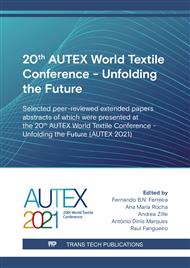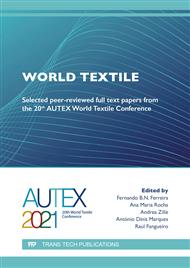[1]
WHO (World Health Organization), Blindness and vision impairment,, WHO, Feb. (2021).
Google Scholar
[2]
International Agency for the Prevention of Blindness (IAPB), Latest statistics on the prevalence of blindness and low vision worldwide – Living Well With Low Vision,, Mar. (2021).
Google Scholar
[3]
M. Lindstrom, BrandSense: Os Segredos Sensoriais que nos Levam a Comprar. Lisboa: Gestão Plus, (2013).
Google Scholar
[4]
M. A. Williams, C. Neylan, and A. Hurst, Preliminary Investigation of the Limitations Fashion Presents to Those with Vision Impairments,, Fash. Pract., vol. 5, no. 1, p.81–105, 2013,.
DOI: 10.2752/175693813x13559997788808
Google Scholar
[5]
S. J. Jones, Fashion Design, Third Edit. London: Laurence King Publishing, (2011).
Google Scholar
[6]
J. Peck and S. B. Shu, The effect of mere touch on perceived ownership,, J. Consum. Res., vol. 36, no. 3, p.434–447, 2009,.
DOI: 10.1086/598614
Google Scholar
[7]
S. M. J. van Osselaer and C. Janiszewski, A Goal-Based Model of Product Evaluation and Choice,, J. Consum. Res., vol. 39, no. 2, p.260–292, 2012,.
DOI: 10.1086/662643
Google Scholar
[8]
S. M. Baker, Consumer normalcy: Understanding the value of shopping through narratives of consumers with visual impairments,, J. Retail., vol. 82, no. 1, p.37–50, 2006,.
DOI: 10.1016/j.jretai.2005.11.003
Google Scholar
[9]
J. Linden and C. Brendler, The hierarchy of needs to inclusive design,, Work, vol. 41, no. SUPPL.1, p.1357–1361, 2012,.
DOI: 10.3233/wor-2012-0324-1357
Google Scholar
[10]
Y. Zhang, The impact of brand image on consumer behaviour: A literature review,, Open J. Bus. Manag., vol. 03, no. 01, p.58–62, 2015,.
Google Scholar
[11]
H. J. Chang and S. Y. Lee, Special Apparel Needs of Consumers with Visual Impairments,, 2015 ITAA Annu. Conf. Proc., p.0–2, (2015).
Google Scholar
[12]
S. Cho, L. Aflatoony, K. Morris, and A. Uriyo, Development of garment design strategies for women with visual impairments,, Int. J. Fash. Des. Technol. Educ., vol. 13, no. 2, p.181–189, 2020,.
DOI: 10.1080/17543266.2020.1761461
Google Scholar
[13]
Designer website, https://www.camichiriboga.com/veo, last accessed, 2021/03/28, last accessed 2020/03/20.
Google Scholar
[14]
Informative website, https://3dprint.com/161341/babette-sterling-fashion-design/, last accessed 2020/05/20.
Google Scholar
[15]
Designer website, https://twoblindbrothers.com/pages/about-us last accessed 24/08/(2021).
Google Scholar
[16]
Informative website, http://www.topbilling.com/articles/Balini-Naidoo-talks-to-Top-Billing-about-her-braille-friendly-fashion.html?articleID=3747, last accessed 15/09/(2021).
Google Scholar
[17]
Information on https://blindgrit.com/about, last accessed 15/09/(2021).
Google Scholar
[18]
Gigilashvili, D., Thomas, J.-B., Pedersen, M., & Hardeberg, J. Y., On the appearance of objects and materials: Qualitative analysis of experimental observations. Journal of the International Colour Association, 26–55, (2021).
Google Scholar
[19]
Brand website, https://tecnikoa.com/info-4d/, last accessed 15/08/(2021).
Google Scholar
[20]
H. Palmer, Conceitos de tendências O/I 21/22: materiais,, 2020. [Online]. Available: https://www.wgsn.com/pt.
Google Scholar
[21]
B. Lawson, How Designers Think, Third Edit. Elsevier, (1997).
Google Scholar
[22]
P.-S. Chow, C.-H. Chiu, A. C. Y. Yip, and A. K. Y. Tang, Contemporary Case Studies on Fashion Production, Marketing and Operations. Springer, (2017).
Google Scholar
[23]
Y. Erikson, Tactile Reading: Tactile Understanding,, in Assistive Technology for Blindness and Low Vision, Taylor and Francis, (2013).
DOI: 10.1201/9781315216935-13
Google Scholar
[24]
D. Atkinson, S. Baurley, B. B. Petreca, N. B. Berthouze, and P. Watkins, The tactile triangle: a design research framework demonstrated through tactile comparisons of textile materials,, J. Des. Res., vol. 14, no. 2, p.142, 2016,.
DOI: 10.1504/jdr.2016.077015
Google Scholar
[25]
M. A. Williams, C. Neylan, and A. Hurst, Preliminary Investigation of the Limitations Fashion Presents to Those with Vision Impairments,, Fash. Pract., vol. 5, no. 1, p.81–105, 2013,.
DOI: 10.2752/175693813x13559997788808
Google Scholar
[26]
A. Gallace and C. Spence, Tactile aesthetics : Towards a definition of its characteristics and neural correlates,, Soc. Semiotic., no. September 2011,.
DOI: 10.1080/10350330.2011.591998
Google Scholar
[27]
J. E. Workman, Fashion consumer groups, gender, and need for touch,, Cloth. Text. Res. J., vol. 28, no. 2, p.126–139, 2010,.
Google Scholar
[28]
P. H. Bloch, F. F. Brunel, and T. J. Arnold, Individual Differences in the Centrality of Visual Product Aesthetics: Concept and Measurement,, J. Consum. Res., vol. 29, no. 4, p.551–565, 2003,.
DOI: 10.1086/346250
Google Scholar
[29]
ASTM E284-17 Standard Terminology of Appearance,ASTM International, West ConshohockenPA(USA),.
Google Scholar
[30]
CIE 175:2006, A framework for the measurement of visual appearance, International Commission on Illumination.
Google Scholar
[31]
Malhotra, N. K. Information and Sensory Overload Information and Sensory Overload in Psychology and Marketing.
DOI: 10.1002/mar.4220010304
Google Scholar
[32]
B. Munari, Das coisas nascem as coisas. Lisboa: Edições 70, (1981).
Google Scholar
[33]
J. Clarkson, R. Coleman, I. Hosking, and S. Waller, Inclusive design toolkit. Cambridge: University of Cambridge, (2007).
Google Scholar
[34]
D. A. Norman, Living with Complexity. (2011).
Google Scholar
[35]
B. Munari, Das coisas nascem as coisas. Lisboa: Edições 70, (1981).
Google Scholar
[36]
J. Clarkson, R. Coleman, I. Hosking, and S. Waller, Inclusive design toolkit. Cambridge: University of Cambridge, (2007).
Google Scholar
[37]
D. A. Norman, Living with Complexity. (2011).
Google Scholar
[38]
A. Rocamora and S. Anneke, Thinking through fashion: A guide to key theorists. London, NY: Bloomsbury Publishing, (2015).
Google Scholar
[39]
M. Ruppert-Stroescu and J. M. Hawley, A Typology of Creativity in Fashion Design and Development,, Fash. Pract. J. Des. Creat. Process Fash., vol. 6, no. 1, p.9–36, 2014,.
DOI: 10.2752/175693814x13916967094759
Google Scholar
[40]
P. Bloch, F. F. Brunel, and T. J. Arnold, Individual Differences in the Centrality of Visual Product Aesthetics,, J. Consum. Res., vol. 29, no. March, p.551, 2003,.
DOI: 10.1086/346250
Google Scholar
[41]
M. Lindstrom, BrandSense: Os Segredos Sensoriais que nos Levam a Comprar. Lisboa: Gestão Plus, (2013).
Google Scholar
[42]
N. Pals, M. G. D. Steen, D. J. Langley, and J. Kort, Three Approaches to Take the User Perspective into Account During New Product Design,, Int. J. Innov. Manag., vol. 12, no. 3, p.275–294, 2008,.
DOI: 10.1142/s1363919608002023
Google Scholar



